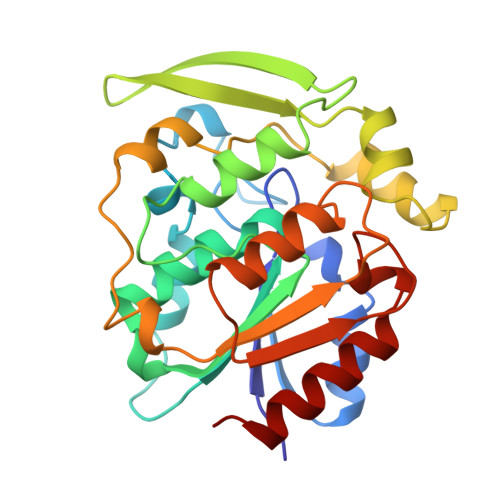Three-dimensional structures of enzyme-substrate complexes of the hydroxynitrile lyase from Hevea brasiliensis.
Zuegg, J., Gruber, K., Gugganig, M., Wagner, U.G., Kratky, C.(1999) Protein Sci 8: 1990-2000
- PubMed: 10548044
- DOI: https://doi.org/10.1110/ps.8.10.1990
- Primary Citation of Related Structures:
2YAS, 3YAS, 4YAS, 5YAS, 6YAS, 7YAS - PubMed Abstract:
The 3D structures of complexes between the hydroxynitrile lyase from Hevea brasiliensis (Hb-HNL) and several substrate and/or inhibitor molecules, including trichloracetaldehyde, hexafluoracetone, acetone, and rhodanide, were determined by X-ray crystallography. The complex with trichloracetaldehyde showed a covalent linkage between the protein and the inhibitor, which had apparently resulted from nucleophilic attack of the catalytic Ser80-Ogamma. All other complexes showed the substrate or inhibitor molecule merely hydrogen bonded to the protein. In addition, the native crystal structure of Hb-HNL was redetermined at cryo-temperature and at room temperature, eliminating previous uncertainties concerning residual electron density within the active site, and leading to the observation of two conserved water molecules. One of them was found to be conserved in all complex structures and appears to have mainly structural significance. The other water molecule is conserved in all structures except for the complex with rhodanide; it is hydrogen bonded to the imidazole of the catalytic His235 and appears to affect the Hb-HNL catalyzed reaction. The observed 3D structural data suggest implications for the enzyme mechanism. It appears that the enzyme-catalyzed cyanohydrin formation is unlikely to proceed via a hemiacetal or hemiketal intermediate covalently attached to the enzyme, despite the observation of such an intermediate for the complex with trichloracetaldehyde. Instead, the data are consistent with a mechanism where the incoming substrate is activated by hydrogen bonding with its carbonyl oxygen to the Ser80 and Thr11 hydroxy groups. A hydrogen cyanide molecule subsequently replaces a water molecule and is deprotonated presumably by the His235 base. Deprotonation is facilitated by the proximity of the positive charge of the Lys236 side chain.
Organizational Affiliation:
Abteilung für Strukturbiologie, Institut für Physikalische Chemie, Karl-Franzens Universität Graz, Austria.
















